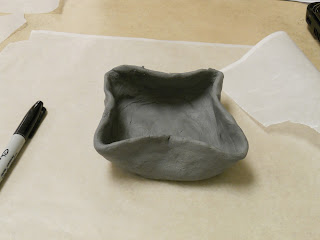 |
| Making a coiled clay pot- not as easy as it sounds! |
Neil gave his talk about the museum and why it was important, then showed the kids (5-8 graders) some of our collection of arrowheads and points and explained why it was important that they not pick up anything they find in the desert. There used to be arrowheads, ollas, and all kinds of artifacts just lying around on the ground and as late as the 1980s people talked about how many they would see on hikes. Enough people picked things up as souvenirs or used the ollas as target practice that you don't see that anymore. Which is sad, since it takes away so much of the culture we're trying to preserve. When you just pick something up you've completely erased it's archaeological value, and most of the story of that object is lost since it wasn't properly documented. The kids enjoyed looking at the different kinds of points, although some of our dating got thrown off when one of the moms told Neil that many of the kids were being taught Creationism and so believed the world was only 6,000 years old. Fortunately Neil had read an article about the 'New Earth' theory that talked about how volcanic eruptions like Mount Saint Helens could mimic what 'Old Earth' proponents claimed took millions of years to compress earth, and therefore turn an artifact dated 10,000 years old into a 3,000 year old artifact. There was science involved in the article that I certainly didn't get, and I don't think any non-science person would try to (which is a whole different debate), but it did require a little change on what Neil was saying. He was more than up to the task. I learn a lot watching him! Then the real fun began. The kids got chunks of clay and got to try their hand at making the base of their own pots. Next week they get to add on to the bases they made this week.
 |
| One of the few original ollas paddles left, from our collection |
The basic idea we use is: take a foam ball for a base, cover it in a damp cloth. Flatten out some clay to act as your base on the bottom of the pot and then you make coils of clay and add them to the base. Rolling snakes out of clay vied with smashing the clay onto the table as the favorite part for these kids. Once you have a few 'snakes' on the ball you take a wooden paddle and smash the clay flat (another favorite and enthusiastically tried part for kids), so the coils disappear. The real problem we have right now is that we don't have a kiln to fire the pots. We keep trying for it in grants, but so far no luck. We use a bar-b-q pit instead. The old clay we used worked fine. The new kind tends to explode in the fire. So we experiment and keep hoping to get a kiln eventually!
The general rule of thumb is that it takes about 4 tries before you have a base worth keeping and using for your pot. One of our kids made a really good one his first try, which I think discouraged some of the others. But they got into it. What kid doesn't like playing with clay as a school project?
 |
| Jacob swears he meant for his pot to come out in this shape |
No comments:
Post a Comment